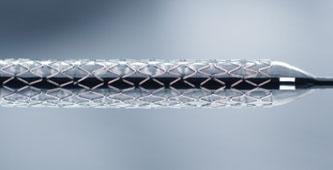
While short term trial outcomes of the Endeavor Zotarolimus-Eluting Coronary Stent favored the Cypher Sirolimus-Eluting Coronary Stent, long-term results favored Endeavor.
Final five-year results from the ENDEAVOR III trial, comparing the Endeavor Zotarolimus-Eluting Coronary Stent to the Cypher Sirolimus-Eluting Coronary Stent, showed Endeavor had lower long-term rates of adverse events, cardiovascular death and heart attacks. The results were released last week during the American College of Cardiology’s 59th Scientific Session.
“I think physicians using the Endeavor will feel even more bolstered and reassured about using Endeavor,” said David Kandzari, M.D., director of interventional cardiology research at Scripps Clinic in La Jolla, Calif., and co-principal investigator ENDEAVOR III and ENDEAVOR IV clinical studies. “Over the long term the hallmark of the Endeavor stent is safety.”
Major adverse cardiac events (MACE) were 13.6 percent for Endeavor, verses 21.8 percent for Cypher. Rates for cardiac death/myocardial infarction (CD/MI) were Endeavor 1.3 vs. 6.5 percent for Cypher. Definite and probable stent thrombosis (ST) rates were Endeavor 1 vs. 3.7 percent for Cypher.
Target Lesion Revascularization Rates Differ
Cypher did fair better than Endeavor in target lesion revascularization (TLR) rates – Endeavor 8 vs. 6.5 percent for Cypher.
“Most of the target lesion revascularizations are occurring in the first year,” Dr. Kandzari said. “When we look at patients treated with Endeavor after one year, we see very low rates of target lesion revascularization. It does support the notion that while TLR is higher earlier on, that difference starts to erode over time.”
The TLR rates between years two through five showed late catch-up in TLR with Cypher, with an increase of 86 percent compared to 21 percent with the Endeavor. Additionally, MACE increased in the Cypher patients by 173 percent compared to 74 percent in the Endeavor patients.
While the results observed increase in late clinical events with the Cypher, the trial was not designed or powered to detect differences in clinical events. The randomized, controlled trial had a primary angiographic endpoint of late lumen loss at eight months. “Despite differences early on with early late loss, it did not translate into late loss,” Dr. Kandzari said.
The definitive study comparing the Endeavor to Cypher is PROTECT, which includes 8,800 patients. It is designed to evaluate whether the Endeavor protects against late stent thrombosis and results in fewer deaths and heart attacks at three years. Enrollment in the PROTECT study was completed in December 2008.
Pooled Endeavor Results
Pooled results from several clinical trials for the Endeavor also show very good longer-term results, including a low rate of late repeat revascularization and few late stent thrombotic events. Five-year findings from the comprehensive ENDEAVOR clinical trial program were also released at ACC 2010.
The E-Pooled analysis includes clinical data on more than 2,100 Endeavor patients from six clinical trials. These include five-year data from the ENDEAVOR I (E-I), ENDEAVOR II (E-II), E-II Continued Access (CA), and ENDEAVOR III (E-III) clinical studies, and three-year data from the ENDEAVOR IV (E-IV) and ENDEAVOR Pharmacokinetics (E-PK) clinical studies. The results were consistent across these studies.
“The consistency of results across these well conducted clinical trials is remarkable,” Dr. Kandzari said. “The Endeavor stent has demonstrated a very compelling safety and efficacy profile wherein there is a very low likelihood that patients treated with the Endeavor stent will experience late stent clotting or the need for a repeat procedure beyond the first year of follow up.”
The E-Pooled analysis includes patients who were treated with the Endeavor DES (in E-I, E-PK, E-II, E-II CA, E-III and E-IV trials) and uses the Medtronic Driver bare-metal stent (BMS) control arm of E-II as a comparator.
Of particular relevance are the longitudinal safety results, including the low rates of cardiac death/myocardial infarction and probable stent thrombosis, which are achieved against a background of only 39 percent and 8 percent of Endeavor patients being maintained on dual-anti-platelet therapy at one year and five years of follow-up, respectively.
Study Questions Endeavor’s Efficacy
Despite these positive findings, they are disputed by the data from the Danish SORT OUT III trial comparing Endeavor to Cypher. The latest results from that trial were also presented at ACC 2010. In that study, data shows patients treated with Endeavor had more MACE events at 18 months than those treated with Cypher.
The main risk reduction that favored Cypher was in TLR (Endeavor 6 vs. 2 percent for Cypher). Data also showed lower rates of myocardial infarction (MI was Endeavor 2 vs. 1 percent for Cypher). Dr. Klaus Rasmussen from Aarhus University Hospital where the study was conducted said the Endeavor stent is no longer used at the hospital because of the findings.
Medtronic, which manufactures Endeavor, said the SORT-OUT III study used unconventional design and analytical methods, which are biased against Endeavor. Unlike the Endeavor clinical trials that used randomized controlled trials with rigorous patient follow-up, SORT-OUT III is dependent on patient records from a national database, the company said. The investigators themselves – not an independent clinical events committee – also determined and verified stent thrombosis, TLR, MI and restenosis. The study was also criticized for being positioned as a real-world study, but nearly 60 percent (3,344) of eligible patients were excluded in the analysis. Differences in patient adherence to dual anti-platelet therapy regimens were also not reported, despite the potential affect on safety outcomes.
Dr. Kandzari said Endeavor makes up about a third of the U.S. DES market.



 April 16, 2024
April 16, 2024 








